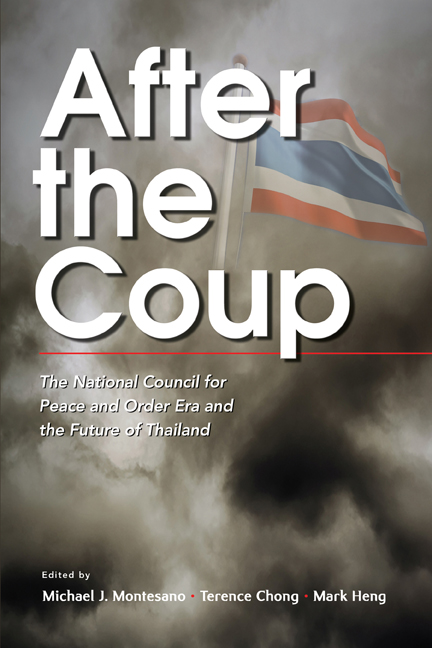Book contents
- Frontmatter
- Contents
- About the Contributors
- 1 Introduction: Thai Realities and Possibilities after the 22 May Coup
- 2 The Rise of the Thai Upper Middle Class and its Turn against Democracy
- 3 “We the Southerners Come to Protect the Nation and the King”: Southerners’ Political Rise and Regional Nationalism in Thailand
- 4 Exit, Voice, (Dis)loyalty? Northeast Thailand after the 2014 Coup
- 5 The Red Shirts and their Democratic Struggle in Northern Thailand, April 2010 – May 2015
- 6 The Shifting Battleground: Peace Dialogue in Thailand's Malay-Muslim South
- 7 Thailand's Zigzag Road to Democracy: Continuity and Change in Military Intervention
- 8 Murder and Regress: Violence and Political Change in Thailand
- 9 Thailand's Politics of Decentralization: Reform and Resistance before and after the May 2014 Coup
- 10 Change and Continuity in the Politics of the Media after the Coup
- 11 Thailand's Royal Democracy in Crisis
- 12 The Foreign Press and its Changing Perceptions of the Thai Monarchy
- 13 Thai Economic Growth: Retrospect and Prospect
- 14 Features and Challenges of an Ageing Population in Thailand
- 15 Conclusion: Thailand in Transition
- Bibliography
- Index
14 - Features and Challenges of an Ageing Population in Thailand
Published online by Cambridge University Press: 23 May 2019
- Frontmatter
- Contents
- About the Contributors
- 1 Introduction: Thai Realities and Possibilities after the 22 May Coup
- 2 The Rise of the Thai Upper Middle Class and its Turn against Democracy
- 3 “We the Southerners Come to Protect the Nation and the King”: Southerners’ Political Rise and Regional Nationalism in Thailand
- 4 Exit, Voice, (Dis)loyalty? Northeast Thailand after the 2014 Coup
- 5 The Red Shirts and their Democratic Struggle in Northern Thailand, April 2010 – May 2015
- 6 The Shifting Battleground: Peace Dialogue in Thailand's Malay-Muslim South
- 7 Thailand's Zigzag Road to Democracy: Continuity and Change in Military Intervention
- 8 Murder and Regress: Violence and Political Change in Thailand
- 9 Thailand's Politics of Decentralization: Reform and Resistance before and after the May 2014 Coup
- 10 Change and Continuity in the Politics of the Media after the Coup
- 11 Thailand's Royal Democracy in Crisis
- 12 The Foreign Press and its Changing Perceptions of the Thai Monarchy
- 13 Thai Economic Growth: Retrospect and Prospect
- 14 Features and Challenges of an Ageing Population in Thailand
- 15 Conclusion: Thailand in Transition
- Bibliography
- Index
Summary
The world is experiencing an increase in the number of elderly people, aged sixty and over. There were approximately 841 million aged people worldwide in 2005, and this number is projected to increase to more than two billion in 2050 (United Nations 2013a, p. 75). While this global trend is more advanced in developed countries, where life expectancy is greater and healthcare better, it has also recently become apparent in developing countries whose economies have enjoyed rapid economic growth (Kinsella and Phillips 2005). Projections show that the percentage of the ageing population in developing countries will soar by 140 per cent within the next two decades (United Nations 2007).
Asia is on the path of demographic transition towards an ageing population. More than half of the world's population aged sixty-five and over is in Asia, and Asia will become the “oldest” region in the world in the next few decades (Menon and Melendez-Nakamura 2009, p. 2). Within Asia, East Asian countries have become ageing societies more rapidly and have a higher proportion of elderly than Southeast Asian countries. However, “population ageing” in the latter is projected to increase at a more rapid rate during the next five decades (Mujahid 2006, p. 5).
The phenomenon of population ageing has caught the world's attention, as it generates many challenges and significantly affects local, regional and global health and economic conditions (McCall 2001; Norton 2000). More advanced ageing countries have witnessed challenges in the areas of long-term care (Wiener and Tilly 2002, pp. 777–78), the financial sustainability of pension systems and the well-being of the elderly (Beard et al. 2011, pp. 18–20; Restrepo and Rozental 1994, pp. 1328–33).
Although demographic transformation is widespread, the change varies in degree and pace among countries and regions. Ageing has proceeded more gradually in developed countries, thus affording them decades to introduce policies and infrastructure to deal with this change. On the other hand, developing countries face a particular set of challenges; namely, the predicament of getting old before getting rich and having less time, fewer resources and less technology to adapt to the many implications of demographic change (Bloom et al. 2011, pp. 31–32). The question that this chapter poses is, what are the specific features of Thailand's ageing population, the challenges that it poses, and their long-term socio-economic and political consequences?
- Type
- Chapter
- Information
- After the CoupThe National Council for Peace and Order Era and the Future of Thailand, pp. 357 - 380Publisher: ISEAS–Yusof Ishak InstitutePrint publication year: 2019

